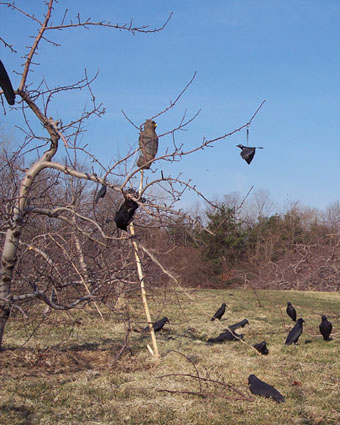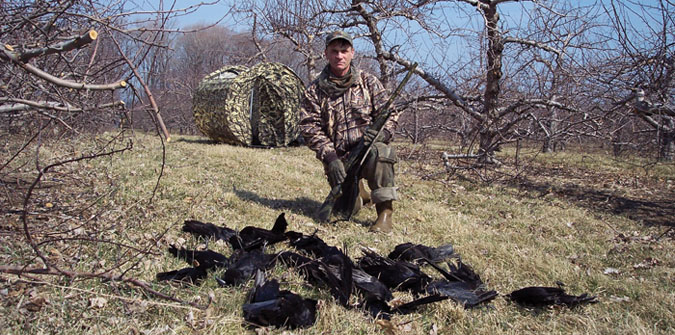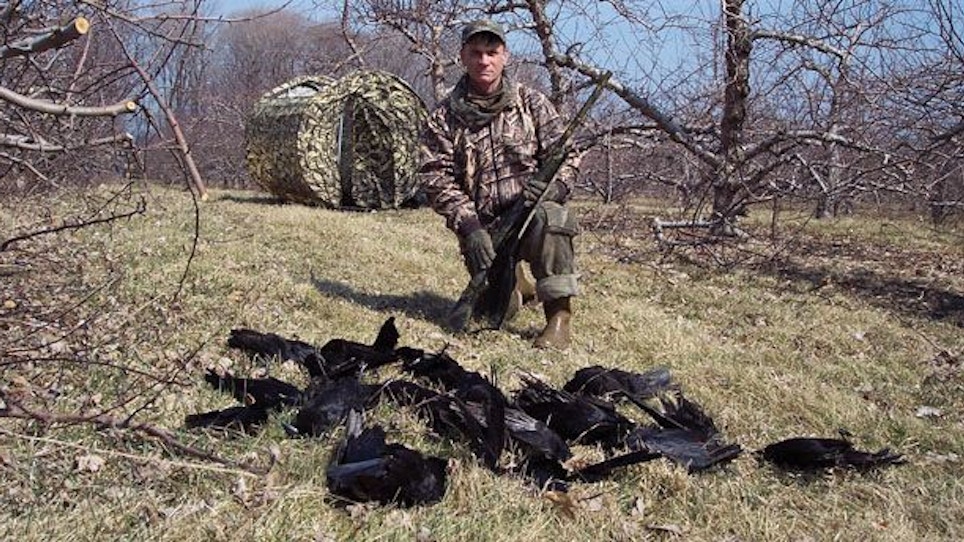 I lowered the volume and the clamor of fighting crows subsided. Six crows barreled towards our setup and I didn’t want to spook them with too much volume. The black bandits cawed back loudly, anxious to join our party. The lead bird tucked its wings and dove in, focused on the decoys. Mike rose from the hay bale blind and folded it I swung the 20-gauge at the next bird in line. It was already flaring as I fired. Mike fired his second shot at a departing bird. Mike had a double, I had nothing. I blamed the gun, then my shells, but I could tell Mike didn’t buy it. It was early March in upstate New York and we were set up in an apple orchard off the shore of Lake Ontario, in the middle of a crow migration flyway. I reached for my thermos of coffee to drown my sorrows when a distant “caw, caw, caw” caught my ear. I clicked on the caller and scanned the sky. I soon spotted three black dots along the lakeshore. Seeing our decoys, they turned in our direction.
I lowered the volume and the clamor of fighting crows subsided. Six crows barreled towards our setup and I didn’t want to spook them with too much volume. The black bandits cawed back loudly, anxious to join our party. The lead bird tucked its wings and dove in, focused on the decoys. Mike rose from the hay bale blind and folded it I swung the 20-gauge at the next bird in line. It was already flaring as I fired. Mike fired his second shot at a departing bird. Mike had a double, I had nothing. I blamed the gun, then my shells, but I could tell Mike didn’t buy it. It was early March in upstate New York and we were set up in an apple orchard off the shore of Lake Ontario, in the middle of a crow migration flyway. I reached for my thermos of coffee to drown my sorrows when a distant “caw, caw, caw” caught my ear. I clicked on the caller and scanned the sky. I soon spotted three black dots along the lakeshore. Seeing our decoys, they turned in our direction.
As the trio closed in, I peeked out of my hay-bale blind to get a better look, forgetting I had removed my facemask to drink my coffee. At 100 yards they picked up my sudden movement and flared away, heading back to the lakeshore. I was going to have to get my act together if I expected better results.
Crow Facts
Hunters have a way of underestimating crows. The birds have tremendous eyesight, ranking with waterfowl in their ability to spot movement. They are one of the most intelligent of all birds, often living to 10 years of age. The oldest crow on record was 29 years old, and discovered in a banding study in 1988. Crows are effective predators and omnivorous feeders. They are constantly on the move and because of this hyperactivity require large amounts of food to maintain body metabolism. An adult crow fills its crop eight to ten times a day. They eat anything, from road kill to dumpster scraps, and among their favorite treats are bird eggs. Crows are nest raiders. Besides eating the eggs, they will pluck a young bird or duckling from its nest without hesitation. The Department of Agriculture conducted a survey of crow predation on waterfowl nesting grounds in the U.S. supplemented with data from Canada. The facts revealed that crows destroyed one-third of waterfowl egg production. So for every crow I harvest, I figure I save a dozen ducks, not to mention songbirds.
Migrating Crows
A high percentage of crows migrate, and use specific flyways year after year. Find these flight paths, and you can have some great late-winter wingshooting as the birds push north. Crows rarely fly over large expanses of water. They fly along the south shoreline of the Great Lakes until they reach an area were they can steer north over land to their nesting grounds in Canada. Flock sizes range from 30 birds down to just a few birds.
Since a high percentage of crows migrate, they are regulated by federal game laws. The Fish & Wildlife Service allows a 124-day season, but specifies that hunting is not allowed during the crow-nesting period. In New York, the season runs from September 1 though March 31, but hunting is only permitted on Friday though Monday each week. States set their own seasons, but they must be within federal guidelines. Check your state’s regulations before you go crow hunting.

Winter Roosts
Roost hunting is a good way to bag winter crows. When hunting roost crows it is important to pattern the birds. Get a binocular, jump in your vehicle and follow the crows out of the roost in the morning. Then, check back in the late afternoon and follow them back to the roost. They use the same flyways daily. Flyways are where you should set up; never close to the roost. Crows will move out of the area if you hunt within sight of the roost — you are better off setting up in flyways a mile or so from the roost. Afternoons are far better than morning. When the birds leave in the morning, they move in big flocks. In the afternoon, they trickle back in smaller groups. This spreads out the shooting. The same roosts are used year after year. Find one and you can count on birds being there annually.
Decoy Low Down
Place decoys where distant crows can see them best. In the orchard along the lake, we drag out trees cut in the nearby hardwoods. Then, we wire three or four decoys to each tree, propping them up against a shorter apple tree. Wire is used to secure the tall saplings to the apple tree. This puts the decoys higher than any other trees in the orchard, making them more visible from a distance. Another trick is to tie 30 feet or so of twine to the loop in the back of the decoy, then throw the decoy up over as high a branch as you can. Pull the decoy tight to the branch and tie the end to a lower branch. Owl decoys work great, especially with a dead or wounded crow tied on a branch below it. Owls are a crow’s mortal enemies.
Occasionally, when crows are hunted hard, they become educated to owl decoys. Use a deer hide on the ground surrounded by decoys. Crows usually swoop in for a look. As is true with any decoy spread, movement helps greatly. There are a few flapper crow and owl decoys on the market that really add realism to a set up. Like waterfowl, incoming crows seem to concentrate on that movement and beeline straight for it.
Crow Callers
A hand call works, although it probably doesn’t have the volume needed on windy days. Hand calls complement an electronic caller when birds get within 100 yards or so. Growling into a hand call in conjunction with the electronic caller can help convince crows to make a final commitment. Many times I will use both cassette and digital callers. I hang my remote control digital in the tree close to the decoys, set on a dying crow sound. I then hook the cassette caller in the blind with the speaker outside in a branch or bush, pointed in the direction from which I expect crows.
One mistake crow hunters often make is pointing speakers straight up. Crows usually fly to the source of the sound and if the speaker is pointed straight up it makes their approach much higher. For general calling I like the Crow and Owl Fight sound. When birds are spotted I’ll then turn it on. As they close within 200 yards, I use the digital. With this combination, they can’t resist joining the festivities.
Bonus Shooting
One benefit to hunting winter crows is that most landowners are more than happy to let you hunt , sometimes leading to other hunting opportunities in the fall. Another plus is that there probably is no harvest limit (but check your state regs). It’s a great tune-up for waterfowling.
Back To My Hunt
It was almost noon and we hadn’t seen a crow for a half-hour. We had killed 20 crows in a five-hour hunt and decided to quit. I had just lowered our decoy tree when I spotted a large flock. I yelled to Mike to turn on the caller. The sound turned several crows our direction. I dove back into the hay bale blind and grabbed the over/under. Within seconds there were targets everywhere. We rose together and fired; amazingly, we picked the same bird to shoot. The flock flared as we both fired again. I tried to get another shot, but the gang was hightailing it out. Still, it was a sweet end to a morning hunt.






